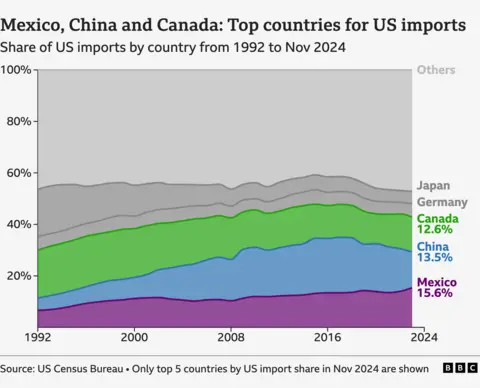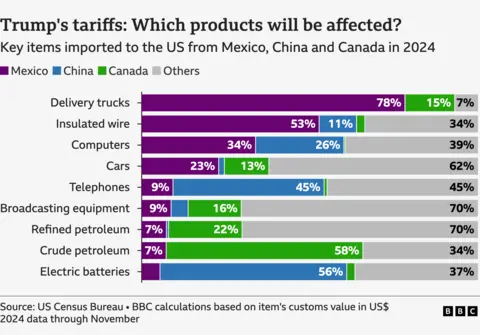BBC News
President Trump has introduced tariffs on goods from China, which has hit back by announcing similar charges on some US products.
Trump has also threatened to introduce tariffs – a tax on imports – on goods from Canada and Mexico, but paused these for 30 days after both countries agreed to boost border security.
The US president has said tariffs are needed to help the American economy and to “protect” the country from the “major threat of illegal aliens and deadly drugs”.
Trump told the BBC tariffs on EU goods could happen “pretty soon” – but suggested a deal could be “worked out” with the UK.
What are tariffs and how do they work?
Tariffs are taxes charged on goods imported from other countries.
Trump introduced a 10% tariff on all goods from China. So, a product worth $10 would have an additional $1 charge applied to it.
The president originally said he would impose a 25% tariff on goods from Canada and Mexico.
Charging a percentage of a product’s value is the most common type of tariff. Another type imposes a fixed figure on imports, whatever their value.
Companies that import goods from abroad pay the tariffs to the US government.

Why is Trump using tariffs?
Trump is fulfilling a campaign promise of introducing import duties against some of America’s closest trading partners.
The tariffs will boost US manufacturing, protect jobs, raise tax revenue and grow the economy, he argues.
Trump says he is also using tariffs to “combat the scourge of fentanyl”, a powerful drug that causes tens of thousands of overdose deaths in the US each year.
His administration says chemicals used to make the drug come from China, while Mexican gangs supply it illegally and have fentanyl labs in Canada.
Canadian Prime Minister Justin Trudeau has said less than 1% of fentanyl entering the US comes from his country.
At the same time Trump is placing economic pressure on these trading partners, he has stated a desire for Canada to join America as the 51st state, an idea Trudeau has firmly rejected.
Together, China, Mexico and Canada accounted for more than 40% of imports into the US last year.
What is happening with China, Canada and Mexico?
China
A 10% charge on all goods imported from China to the US, took effect on 4 February.
In response, China said it would implement a 15% tariff on coal and liquefied natural gas products from 10 February. Crude oil, agricultural machinery and large engine cars will see a 10% tariff.
“Trade and tariff wars have no winners,” said a spokesperson at China’s Washington embassy.
Canada
Canadian Prime Minister Justin Trudeau said Trump’s proposed tariffs of 25% on Canadian goods – which were also set to begin on Tuesday – “will be paused for at least 30 days while we work together”.
Trudeau’s retaliatory 25% tariffs on 155bn Canadian dollars’ worth ($107bn; £86bn) of US imports were also halted.
In exchange for the pause, Trudeau said Canada was implementing a “$1.3bn border plan” to add “new choppers, technology and personnel to border,” as well as “increased resources to stop the flow of fentanyl”.
Much of the border security plan had already been announced in December.
Trump said the delay would allow the US to see “whether or not a final economic deal with Canada” can be reached.
Mexico
The proposed 25% tariffs against Mexico have also been delayed a month, as have measures by Mexico against US goods.
Mexico’s President Claudia Sheinbaum agreed to send 10,000 members of the National Guard to the US-Mexican border to “prevent the trafficking of drugs, in particular fentanyl”.
President Sheinbaum said the US had in turn agreed to increase measures to prevent the trafficking of high-powered US weapons into Mexico.
Which products will be affected?
During Trump’s previous time in office, he applied less restrictive tariffs on China. This time around, the tariffs appear to apply to all goods from China.
Should the measures against goods from Mexico and Canada ultimately go ahead, a range of items are expected to become more expensive
Car manufacturing could bear the brunt of the effects of tariffs.
Vehicle parts cross the US, Mexican and Canadian borders multiple times before a vehicle is completely assembled.
The average US car price could increase by $3,000 because of the import taxes, financial analyst TD economics suggested.
Other goods from Mexico which could be affected include fruit, vegetables, spirits and beer.
Canadian goods such as steel, lumber, grains and potatoes would also be likely to get pricier.
Canadian energy would be tariffed at 10% instead of 25%.

Will the UK and Europe have to pay tariffs?
On Sunday, Trump told the BBC the UK was acting “out of line”, but suggested a solution for the UK could be “worked out”.
But, he said tariffs could be imposed on the EU “pretty soon”, saying “they take almost nothing [from the US] and we take everything from them”.
The UK’s business secretary, Jonathan Reynolds, said the UK should be excluded from tariffs because the US exports more products to the UK than it imports.
The UK exports pharmaceutical products, cars and scientific instruments to the US.
Last year, the US had a trade deficit of $213bn with the EU – which Trump described as “an atrocity”.
The EU has said it would “respond firmly” to any tariffs.
US companies Harley Davidson, which manufactures motorcycles, and whiskey distilleries such as Jack Daniel’s have previously faced EU tariffs.
Do tariffs cause inflation?
Economists suggest that a portion of the cost of tariffs ends up being paid by consumers.
Sellers may raise the price of goods they are importing.
From 2018 to 2023, tariffs on imported washing machines saw the price of laundry equipment rise by 34%, according to official statistics, before falling once the tariffs expired.
Some experts suggest that these new tariffs could prompt a wider trade war and exacerbate inflation.
Capitol Economics said the annual rate of inflation could increase from 2.9% to as high as 4% because of the newly announced tariffs.


